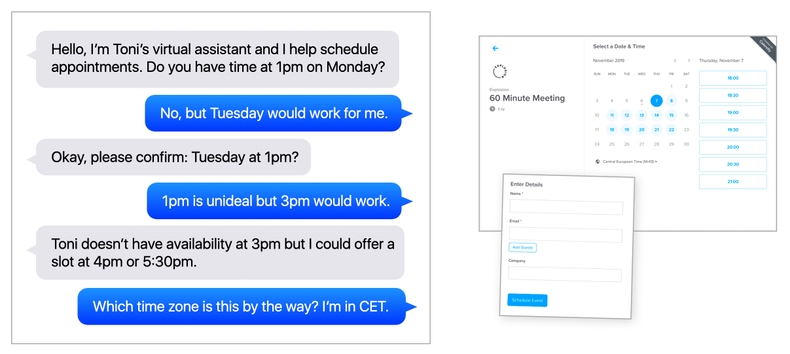The Window-Knocking Machine Test
AI is making futurists of us all. With the dizzying speed of new innovations, it’s clear that our lives and work are going to change. So what’s next? How will technology shape our world going forward? And what tools and products should we build? When imagining what the future could look like, it helps to look back in time and compare past visions to our reality today. The following paintings were created in the early 1900s and depict the artist’s ideas for what life could look like in the year 2000, assisted by new technology.

How people in 1900 imagined the year 2000 (Source: The Washington Post)
Now 2000 has long gone and we know what life really looked like. What all of these visions have in common is that they imagine very literal translations of human-shaped tasks into technology. We did indeed solve many of these problems with technology, but we did it quite differently. We invented vacuum cleaners and robotic mops instead of sweeping machines that operate brooms. Other innovations tackled different problems altogether: we didn’t just engineer fire trucks, planes and drones, but also introduced smoke detectors, modern construction techniques and fireproof materials to prevent fires from breaking out in the first place.
During the Industrial Revolution and up until the 1950s (!), people in Europe would employ so called “knocker-uppers”, who would walk around the neighbourhood with a long stick and knock on windows to ensure their clients woke up in time. This peculiar profession was of course made entirely obsolete by technology when alarm clocks became reliable enough and affordable for everyone. However, knocking on windows was simply a means to an end – we didn’t build window-knocking machines. We built alarm clocks that solved the same problem in a different and much more effective way. Just like how humans knocking on windows was the most effective way before.

“Knocker-uppers” at work (Source: Mashable)
When designing new technological solutions, it’s easy to fall into the trap of imagining them as human-shaped replacements because that’s all we know. But the most successful innovations don’t usually work this way. So whenever you’re tasked with developing a system to replace and automate a human task, ask yourself:
Am I building a window-knocking machine or an alarm clock?
Around 2015 when deep learning was widely adopted and conversational AI became more viable, the industry got very excited about chat bots. Compared to what we can do today, the capabilities were still pretty limited, but optimism and all the new possibilities led to many ambitious product ideas and attempts to make modern workplaces more productive.
Some of the most attractive use cases were centered around automating tasks of personal assistants: placing orders, coordinating people or scheduling appointments. The latter is especially painful and time-consuming, as everyone who’s worked in a role with frequent meetings can attest to. So what if we could make a chat bot take over that conversation?

Two solutions for scheduling meetings: a chat bot and the Calendly app
An alternative approach was introduced by Calendly, a product I love and highly recommend. The premise is simple: Calendly syncs with your calendars and gives you a booking link that lets others schedule appointments in a few clicks, optionally syncing with their calendars, too, and automatically converting time zones. It’s an incredibly effective solution that doesn’t even require AI at its core – it simply reframes the problem and solves it at the root, rather than translating the task performed by a human assistant. You could also say: Calendly is the alarm clock to the window-knocking machine of the chat bot.
Now don’t get me wrong, there are many applications that really benefit from conversational interfaces. But natural language is exactly that: another interface. Whether or not it’s the right interface is a decision you can’t make without considering the specifics of your application and its intended users.
The more recent developments around LLMs and Generative AI have enabled a big leap in natural language understanding technology and also reignited the excitement around chat bots. Retrieval-Augmented Generation (RAG) lets users interact with applications and their specific underlying data, for instance to translate natural language questions into real-time database queries. If you want to know your company’s revenue figures, you can simply ask your bot, instead of looking at a table of numbers.

Two solutions for querying revenue and customer data: a chat bot and a graphical user interface
The decision between alarm clock and window-knocking machine is much less clear-cut in this example and depends a lot on the intended usage. Natural language questions can be much more intuitive for non-experts, but they probably won’t replace the need for structured data as a source of truth that analysts can work with directly. If this is too inefficient, the answer isn’t to abstract it away behind a conversational interface – it indicates that the existing interface needs to be better.
I believe a common misconception about professional tools is that providing a good user experience and making things “simple” requires abstracting away as many layers as possible. That’s how we end up with “one click” or “one line of code” solutions that sound great in theory, but have users hit a wall as soon as they want to do things the developers had not considered or intended. Just because a user is “non-technical” (whatever this means), it doesn’t mean they’re unable or unwilling to use complex professional products – it’s just that those products need to be designed well and get the job done efficiently.
The latest AI technologies have a lot of potential to make humans more productive – but just like with past innovations, the way they’ll translate into products and solutions will likely be very different from our limited imagination of human-shaped tasks. We’re currently seeing a lot of window-knocking machines being built, but only the alarm clocks will remain.